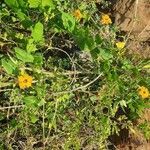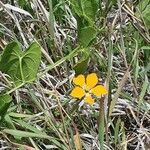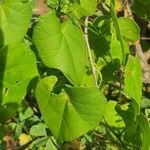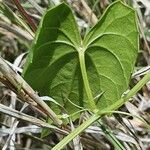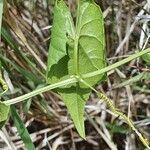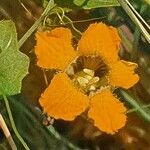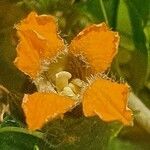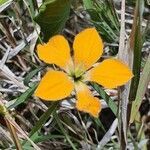Perennial herb. Stems prostrate or scandent, to 7·5 m, glabrous or sparsely and finely shortly pubescent, arising from a tuberous napiform rootstock. Leaf-lamina 1·4-7·5 x 0·8-6·7 cm, narrowly to very broadly ovate in outline, deeply cordate, plane or distinctly sinuate and denticulate, finely asperulous beneath, finely more or less densely asperulous or scabrid-punctate above, unlobed or usually shortly palmately 3-5-lobed, the central lobe largest, triangular, shortly acuminate, acute to obtuse, apiculate, the lateral shorter, more rounded. Petiole 0·4-5 cm long, shortly pubescent. Tendrils simple. Flowers monoecious. Male flowers 1-8 in pedunculate bracteate subumbelliform inflorescences, sometimes accompanied by 1-2 female flowers; peduncle 1·1-10 cm long; bract 3-8 mm long, narrowly lanceolate to linear; pedicels 5-20 mm long. Receptacle-tube 2-5 mm long, lobes 6-17 mm long, narrowly ovate to lanceolate, acutely-acuminate, dark-coloured. Petals 1·3-2·8 cm long, yellow to deep orange above, paler beneath, dark at the base, narrowly obovate. Female flowers solitary or 1-2 accompanying male in mixed inflorescence; when solitary, peduncles 1·7-6·4 mm long and bract subulate, 4-7 mm long; pedicel 2-6 mm long; ovary 4·5-12 x 1-1·5 mm, fusiform, ribbed, finely pubescent on ribs; receptacle-tube 0·5 mm long, lobes 2-5 mm long, narrowly lanceolate, green; petals 0·8-1·6 cm long, obovate. Fruit 2·3-10 x 0·4-0·9 cm, fusiform, green or striped with cream, becoming yellow; fruit-stalk 1·8-11 cm long. Seeds 9-17 x 3-5 x 2-5 mm, ellipsoid, tumid, with terminal verrucose appendices; faces convex, shallowly sculptured, margins slightly flattened.
An annual herb. It climbs by tendrils. These are not branched It grows from a tuberous rootstock. The stems can be 5 m long. The leaves are alternate. They are about 3 cm long by 3 cm wide. They are shallowly divided into 3 lobes. Male and female flowers can be on the same plant or on separate plants. The flowers are orange. There are 1 or 2 female flowers in the axils of leaves. The male flowers are in clusters of 2-5. The fruit is cylinder shaped and 3 cm long by 4 mm wide. It has 2 seeds.
male flowers 1–8 in pedunculate bracteate subumbelliform inflorescences, sometimes accompanied by 1–2 female flowers; peduncle 1·1–10 cm. long; bract 3–8 mm. long, narrowly lanceolate to linear; pedicels 5–20 mm. long. Receptacle-tube 2–5 mm. long, lobes 6–17 mm. long, narrowly ovate to lanceolate, acutely-acuminate, dark-coloured. Petals 1·3–2·8 cm. long, yellow to deep orange above, paler beneath, dark at the base, narrowly obovate.
Prostrate or scandent herb. Tendrils simple, un-branched. Stems and petioles concolorous, uniformly green. Leaf lamina unlobed or usually shallowly 3-5-lobed or-angled; lobes ovate or triangular. Male flowers 1-8, subumbellate, peduncle free from petiole of subtending leaf. Fruit fusiform, 4-8 mm in diameter. Flowers yellow to deep orange above, pale beneath, dark at base; July and November to February.
Leaf-lamina 1·4–7·5 × 0·8–6·7 cm., narrowly to very broadly ovate in outline, deeply cordate, plane or distinctly sinuate and denticulate, finely asperulous beneath, finely more or less densely asperulous or scabrid-punctate above, unlobed or usually shortly palmately 3–5-lobed, the central lobe largest, triangular, shortly acuminate, acute to obtuse, apiculate, the lateral shorter, more rounded.
Female flowers solitary or 1–2 accompanying male in mixed inflorescence; when solitary, peduncles 1·7–6·4 mm. long and bract subulate, 4–7 mm. long; pedicel 2–6 mm. long; ovary 4·5–12 × 1–1·5 mm., fusiform, ribbed, finely pubescent on ribs; receptacle-tube 0·5 mm. long, lobes 2–5 mm. long, narrowly lanceolate, green; petals 0·8–1·6 cm. long, obovate.
Seeds 9–17 × 3–5 × 2–5 mm., ellipsoid, tumid, with terminal verrucose appendices; faces convex, shallowly sculptured, margins slightly flattened.
Stems prostrate or scandent, to 7·5 m., glabrous or sparsely and finely shortly pubescent, arising from a tuberous napiform rootstock.
Fruit 2·3–10 × 0·4–0·9 cm., fusiform, green or striped with cream, becoming yellow; fruit-stalk 1·8–11 cm. long.
Petiole 0·4–5 cm. long, shortly pubescent.
Flowers monoecious.
Tendrils simple.
